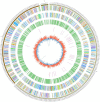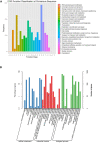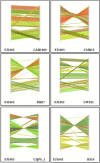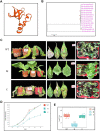Comprehensive genome sequence analysis of the devastating tobacco bacterial phytopathogen Ralstonia solanacearum strain FJ1003
- PMID: 36072670
- PMCID: PMC9441608
- DOI: 10.3389/fgene.2022.966092
Comprehensive genome sequence analysis of the devastating tobacco bacterial phytopathogen Ralstonia solanacearum strain FJ1003
Abstract
Due to its high genetic diversity and broad host range, Ralstonia solanacearum, the causative phytopathogen of the bacterial wilt (BW) disease, is considered a "species complex". The R. solanacearum strain FJ1003 belonged to phylotype I, and was isolated from the Fuzhou City in Fujian Province of China. The pathogen show host specificity and infects tobacco, especially in the tropical and subtropical regions. To elucidate the pathogenic mechanisms of FJ1003 infecting tobacco, a complete genome sequencing of FJ1003 using single-molecule real-time (SMRT) sequencing technology was performed. The full genome size of FJ1003 was 5.90 Mb (GC%, 67%), containing the chromosome (3.7 Mb), megaplasmid (2.0 Mb), and small plasmid (0.2 Mb). A total of 5133 coding genes (3446 and 1687 genes for chromosome and megaplasmid, respectively) were predicted. A comparative genomic analysis with other strains having the same and different hosts showed that the FJ1003 strain had 90 specific genes, possibly related to the host range of R. solanacearum. Horizontal gene transfer (HGT) was widespread in the genome. A type Ⅲ effector protein (Rs_T3E_Hyp14) was present on both the prophage and genetic island (GI), suggesting that this gene might have been acquired from other bacteria via HGT. The Rs_T3E_Hyp14 was proved to be a virulence factor in the pathogenic process of R. solanacearum through gene knockout strategy, which affects the pathogenicity and colonization ability of R. solanacearum in the host. Therefore, this study will improve our understanding of the virulence of R. solanacearum and provide a theoretical basis for tobacco disease resistance breeding.
Keywords: Ralstonia solanacearum; Rs_T3E_Hyp14; bacterial wilt; disease resistance; effector proteins; genome sequencing; tobacco.
Copyright © 2022 Chen, Zhuang, Wang, Li, Lei, Li, Gao, Wei, Dang, Raza, Yang, Sharif, Yang, Zhang, Zou and Zhuang.
Conflict of interest statement
The authors declare that the research was conducted in the absence of any commercial or financial relationships that could be construed as a potential conflict of interest.
Figures







Similar articles
-
Comprehensive genome sequence analysis of Ralstonia solanacearum gd-2, a phylotype I sequevar 15 strain collected from a tobacco bacterial phytopathogen.Front Microbiol. 2024 Mar 14;15:1335081. doi: 10.3389/fmicb.2024.1335081. eCollection 2024. Front Microbiol. 2024. PMID: 38550868 Free PMC article.
-
Complete genome sequence analysis of the peanut pathogen Ralstonia solanacearum strain Rs-P.362200.BMC Microbiol. 2021 Apr 19;21(1):118. doi: 10.1186/s12866-021-02157-7. BMC Microbiol. 2021. PMID: 33874906 Free PMC article.
-
Complete Genome Sequence of Sequevar 14M Ralstonia solanacearum Strain HA4-1 Reveals Novel Type III Effectors Acquired Through Horizontal Gene Transfer.Front Microbiol. 2019 Aug 14;10:1893. doi: 10.3389/fmicb.2019.01893. eCollection 2019. Front Microbiol. 2019. PMID: 31474968 Free PMC article.
-
Ralstonia solanacearum, a widespread bacterial plant pathogen in the post-genomic era.Mol Plant Pathol. 2013 Sep;14(7):651-62. doi: 10.1111/mpp.12038. Epub 2013 May 30. Mol Plant Pathol. 2013. PMID: 23718203 Free PMC article. Review.
-
Pathogenomics of the Ralstonia solanacearum species complex.Annu Rev Phytopathol. 2012;50:67-89. doi: 10.1146/annurev-phyto-081211-173000. Epub 2012 May 1. Annu Rev Phytopathol. 2012. PMID: 22559068 Review.
Cited by
-
The composite microbial agent controls tomato bacterial wilt by colonizing the root surface and regulating the rhizosphere soil microbial community.Front Microbiol. 2025 Apr 30;16:1559380. doi: 10.3389/fmicb.2025.1559380. eCollection 2025. Front Microbiol. 2025. PMID: 40371121 Free PMC article.
-
Key mechanisms of plant-Ralstonia solanacearum interaction in bacterial wilt pathogenesis.Front Microbiol. 2025 Jun 6;16:1521422. doi: 10.3389/fmicb.2025.1521422. eCollection 2025. Front Microbiol. 2025. PMID: 40547798 Free PMC article. Review.
-
Ralstonia solanacearum type III effector RipAF1 mediates plant resistance signaling by ADP-ribosylation of host FBN1.Hortic Res. 2024 Jun 12;11(8):uhae162. doi: 10.1093/hr/uhae162. eCollection 2024 Aug. Hortic Res. 2024. PMID: 39108578 Free PMC article.
-
Comprehensive genome sequence analysis of Ralstonia solanacearum gd-2, a phylotype I sequevar 15 strain collected from a tobacco bacterial phytopathogen.Front Microbiol. 2024 Mar 14;15:1335081. doi: 10.3389/fmicb.2024.1335081. eCollection 2024. Front Microbiol. 2024. PMID: 38550868 Free PMC article.
References
LinkOut - more resources
Full Text Sources
Miscellaneous

